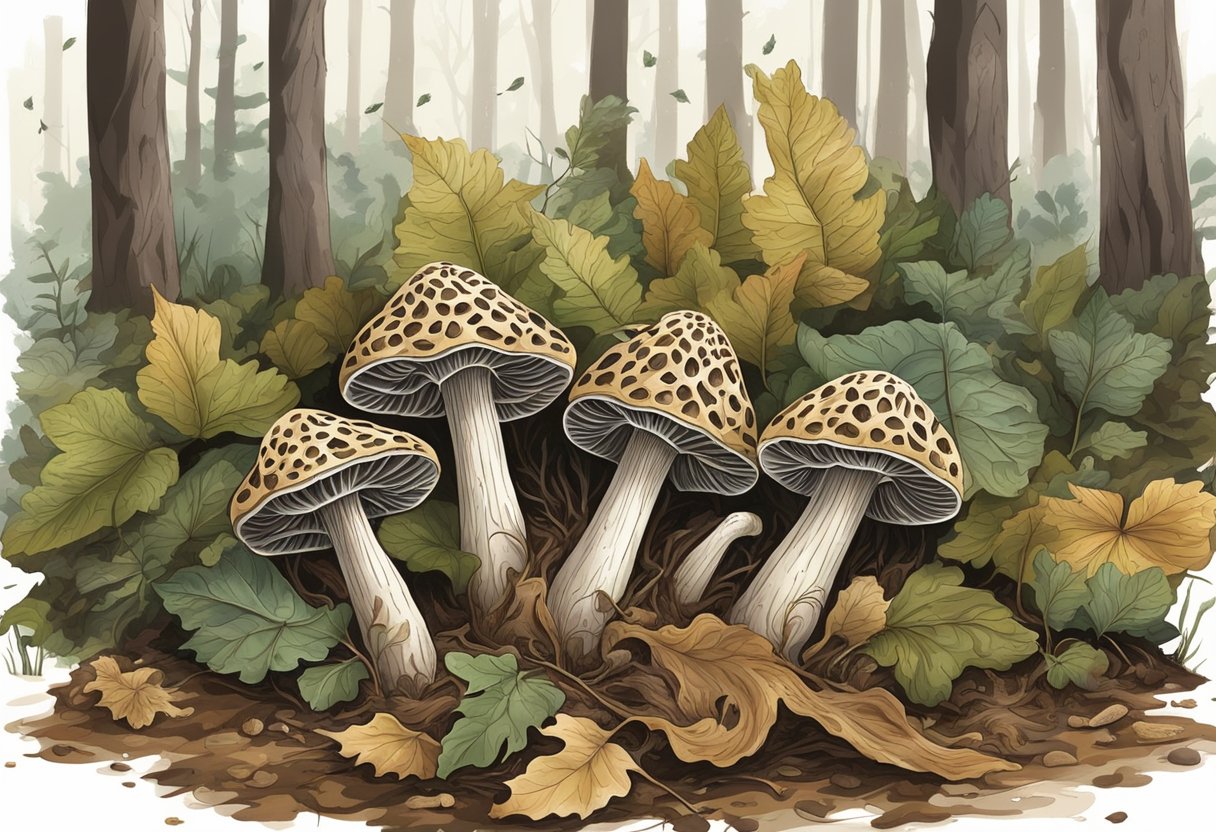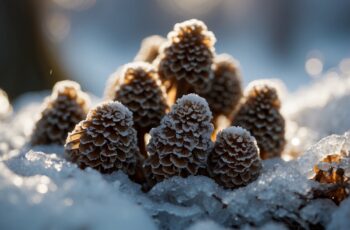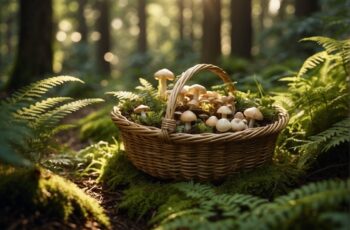Morel mushrooms are a highly sought-after delicacy, revered by chefs and food enthusiasts for their distinctive flavor and texture. Cultivating morels presents unique challenges, as these fungi have specific environmental requirements that must be met. Unlike many other mushroom varieties that can be easily grown on substrates like grain or sawdust, morels demand a symbiotic relationship with certain trees and specific soil conditions, which can make them elusive to cultivate.

Understanding the lifecycle and ecology of morel mushrooms is crucial for successful cultivation. They thrive in temperate regions and are often found in woodland areas, particularly in the vicinity of decaying hardwood. To replicate their natural habitat, factors such as soil composition, moisture levels, temperature, and the presence of appropriate organic matter must be carefully controlled. With proper technique and patience, it is possible to grow morels both outdoors and indoors, although achieving consistent results can be complex and requires detailed knowledge of the mushroom’s growth patterns.
Key Takeaways
- Morel mushrooms have a unique flavor profile, making them a prized ingredient in culinary circles.
- Specific ecological conditions are necessary for morel cultivation, including symbiotic tree relationships and soil composition.
- Successful morel cultivation involves replicating natural habitats and requires patience and attention to the mushroom’s lifecycle.
Understanding Morel Ecology

To cultivate morels effectively, a comprehensive understanding of their natural ecology is crucial. This understanding encompasses the conditions they thrive in, their growth cycle, and the characteristics of different species.
Natural Habitat and Conditions
Morels favor temperate regions and are typically found in deciduous forests. They thrive in loamy soil that has a balanced amount of sand, silt, and clay, with adequate levels of organic matter. The pH of the soil is usually neutral to slightly alkaline. These mushrooms often grow in areas with decaying wood, particularly near aging or dead elm, ash trees, and in areas previously disturbed by natural events where wood chips and wood ash may be present. The presence of burned wood is known to stimulate the appearance of morels, particularly after wildfires or controlled burns.
The Morel Lifecycle
Morels exhibit a unique lifecycle that includes both sexual and asexual reproduction. In the spring, when the soil warms up, the fungal mycelium begins to form fruiting bodies—the actual mushrooms that can be harvested. It is during this time that morel hunters scour woodlands, especially after a rain, as morels are 90% water and rely on these conditions for their fruit bodies to emerge. Growth rate and conditions for the emergence of morels are documented in guides on morel growth rates.
Identifying Morel Species
Morels can be identified by their distinctive honeycomb appearance, with pits and ridges on their caps. Morchella americana, known as the Blonde or Yellow Morel, is one of the most prized species and can be identified through its specific features. While morels can look quite similar, there are a variety of species with subtle differences in color and size that are often specific to certain geographic regions, such as the morels found in Nebraska and Virginia. Understanding these species is vital for both identification and cultivation, as some may have particular habitat and soil pH preferences. A caution for foragers and cultivators is to be aware of false morels, which can be toxic, emphasizing the importance of accurate identification.
Cultivation Techniques
The successful cultivation of morel mushrooms hinges on replicating their natural growing conditions, whether indoors or outdoors.
Indoor Cultivation Methods
To grow morels indoors, enthusiasts generally begin by sterilizing a substrate which often includes a recipe of water, wood chips, and other organic materials conducive to mycelium growth. Mushroom spawn is then introduced to the substrate, which must be kept at the right temperature and humidity levels. The incubation period is crucial, during which the mycelium becomes established before the fruiting phase can begin. Utilizing a comprehensive guide to morel mushrooms spores can provide further insight into this process.
Outdoor Cultivation Approaches
Outdoors, enthusiasts often create a dedicated mushroom bed by loosening soil and adding a mixture of compost, leaves, or woodchips that serve as a substrate. Morel spores or spawn can be distributed across this bed, often covered with peat moss and a wet cheesecloth to maintain adequate moisture levels, simulating the natural conditions morels require. For detailed steps and considerations, referring to a guide on morel spores might be beneficial.
Creating the Right Environment
Both indoor and outdoor cultivation necessitate a controlled environment with specific growing conditions. The cultivation area must have a stable temperature, generally between 60-70°F (15-21°C), and high humidity levels to promote morel fruiting. Agar plates can be used to propagate morel mycelium under sterile conditions before transferring it to a substrate. Keeping the environment free from contaminants is crucial for the development of healthy morel mushrooms.
Harvesting and Utilization
This section addresses the procedures and potential benefits associated with the harvesting, cleaning, preservation, and culinary applications of morel mushrooms.
Harvesting Morels
Harvesting morels is a delicate process that affects both their quality and longevity. Morels should be carefully cut at the stem with a knife rather than pulled, to avoid damaging the sensitive mycelium below ground from which they fruit. This practice allows for future growths and sustains the population of edible mushrooms. After collecting, practitioners often spread the spores to promote regrowth.
Cleaning and Storage
Once harvested, morels must be cleaned as they often harbor forest debris. Gentle brushing or rinsing with a solution of water mixed with salt can help to remove any unwanted particles. For extended storage, morels can be dried, which involves dehydrating them completely before sealing in an airtight container. The process of how to store morel mushrooms ensures that the distinct flavor and texture of these prized fungi are well-preserved.
Culinary Uses
Morels are renowned for their delicious, nutty flavor and make a versatile ingredient in the kitchen. They pair exceptionally well with grain dishes, cream sauces, vegetables, and can be sautéed with gypsum to enhance their taste. They should be cooked thoroughly before consumption. A popular recipe might include morels sautéed with vegetables near apple trees, releasing their rich, earthy flavors.
Health and Nutritional Benefits
As a species of medicinal mushrooms, morels offer various health benefits. They are a good source of vitamins and minerals, particularly vitamin D and B vitamins. They have been linked to immune system support and possess antioxidants. The consumption of morels must be done with caution, as they are only safe to eat when cooked properly. Morels’ nutrition profile makes them a valued addition to a healthy diet.
Frequently Asked Questions
When seeking to cultivate morel mushrooms, enthusiasts and cultivators alike often have numerous inquiries about the process. The following FAQs aim to shed light on the key aspects of morel mushroom propagation and cultivation.
How do you propagate Morel mushrooms?
Propagation of morel mushrooms typically involves creating a morel spore slurry which is then introduced to a suitable habitat. The spores germinate when the conditions align, leading to the growth of mycelium and eventually the fruiting bodies or mushrooms.
What is the best environment for growing Morels?
The optimal environment for morel cultivation includes a moist, loamy soil rich in organic material. Morels thrive in temperate climates with a clear distinction between seasons, specifically requiring a period of cold weather to trigger fruiting.
What are the techniques for Morel mushroom cultivation?
Key techniques for cultivating morels range from outdoor beds in shaded areas to controlled indoor environments. The process can be intricate, attempting to mimic the natural conditions morels require for growth, such as adequate moisture and specific soil composition.
Can Morel mushrooms be reliably grown indoors?
Indoor cultivation of morels is challenging but can be accomplished under carefully controlled conditions that replicate the natural change in seasons and soil characteristics. Success depends on maintaining the precise balance of temperature, humidity, and soil conditions.
What factors lead to a successful Morel harvest?
A successful harvest hinges upon several critical factors: the right spore strain, suitable environmental conditions, and patience. Timing and soil health are also crucial, as they play a significant role in the life cycle of morel mushrooms.
Are there any commercial methods for Morel farming?
While commercial cultivation of morels has been met with limited success compared to other mushroom species, there are ongoing efforts to develop reliable methods for farming morels on a larger scale. These methods seek to replicate the intricate balance of conditions morels naturally necessitate.


